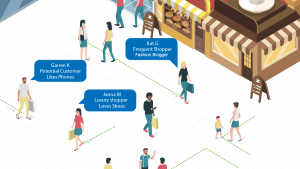In this part of our customer paths and retail store layout series, we’ll continue with strategies that go beyond the retail store layout.

Some of these following tips might be irrelevant to your space. For instance, we cover dressing rooms which clothing retailers and department stores need but other types of brick and mortar retailers won’t have any use for.
Visibility
One key way to reduce inventory losses is to maintain good visibility. We’ve already covered several reasons to have wide aisles but a byproduct of that is it makes it easier for staff to see shoplifters. Low shelves also improves visibility and make sure any temporary displays won’t provide cover for thieves.
Seating
Providing some type of seating outside of dressing rooms for friends who are accompanying shoppers goes a long way. Seating like this is primarily used in clothing stores but it isn’t exclusive. Shoppers get tired from time to time and providing a simple lounge or stools near the checkout enhances the overall customer experience. This is also another great way to slow shoppers down which extends their visit and increases the chances of customers making a purchase.
Dressing Rooms
Dressing rooms for clothing retailers and apparel stores are a must! There’s no getting around this but dressing rooms to take up valuable space, especially when you add in a seating area. Make the most of it by using the dressing room’s exterior walls for accessories, promotional items, and impulse buys– you might get a sale from someone accompanying a shopper! Also, make sure that your changing space meets your local accessibility guidelines.
Checkout
The checkout area is more than just a place to put a cashier. Quite a lot of thought should be put into where it is located and what is around it. For retailers who do not use baskets, having a large counter where shoppers can leave items is essential. Customers with empty hands who aren’t carrying anything are much more likely to pick up even more items. It also comes in handy for an efficient checkout process and space for shoppers to set their personal belongings down.
One of the key concepts we’ve introduced all the way back in part 1 is the right hand turn. Roughly 90% of shoppers will enter a store, turn right, loop around in a counter-clockwise path, and leave on the left side. That means the best place to put your checkout is at the end of that journey on the left side of the entrance since it is part of their natural exit path. Make sure that it’s also a place of high visibility to discourage shoplifting.
Small complementary impulse buy items should be located around the checkout as a shopper waits to pay. The back wall behind the counter is a great place to advertise special promotions. The checkout is the last place to upsell a customer.
Finally, some thought should be put into the back-of-house operations. Inventory, shipping and receiving, and employee workspace or break area needs to be placed somewhere. Having this area located near the checkout and concealed minimizes customer distraction and keeps them focused on shopping.
The next part in this series will cover signage strategies in your space.








